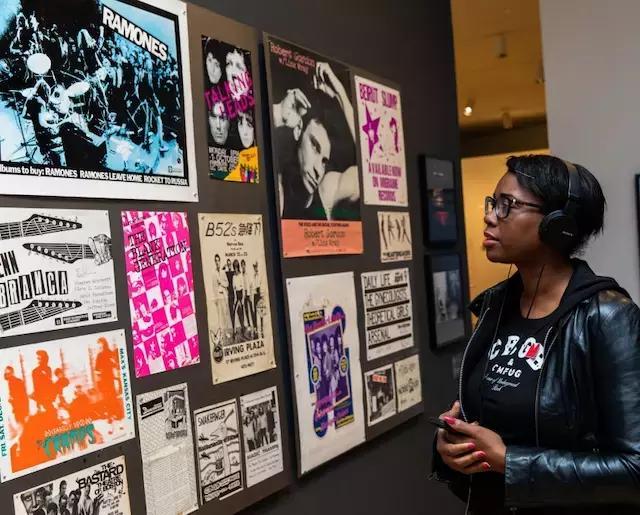朋克文化表達了什么?
Brightly dyed hair, ripped clothes and black leather – Avril Lavigne and Rihanna are just the latest in a long line of artists to embrace the style of punk.
鮮艷的發色、破邊的衣服以及黑色的皮衣 —— 在一眾喜愛朋克風格的音樂人之中,艾薇兒和蕾哈娜只是近期的兩位代表人物。
Punk first exploded onto the British and US music scenes in the 1970s. A new exhibition, titled Too Fast to Live, Too Young to Die: Punk Graphics 1976-1986, opened at New York City's Museum of Arts and Design on April 9. Through hundreds of posters, album covers and magazines, it takes visitors through the history of punk's images.
上世紀70年代,朋克這一概念首次在英美樂壇爆火。一場名為《來去匆匆,英年早逝:朋克圖像1976-1986》的新展覽已于4月9日在紐約市藝術與設計博物館展出。該展覽通過上百張海報、專輯封面以及雜志,帶領參觀者們回顧了朋克圖像的歷史。
The New York Times calls it "a fascinating look" at the anti-authoritarian visual language of punk.
《紐約時報》稱其呈現了朋克文化中反權威視覺語言的“迷人之處”。
Of course, these are just images. What was punk about and why are the images important?
當然,這些都只是圖像罷了。那么,“朋克”究竟是什么?為什么這些圖像如此重要呢?
Punk came about as a working-class reaction to mainstream music and culture. Artists took every aspect of rock music to new extremes. The music was louder and faster. Singers shouted as much as they sang.
朋克源于勞動者階層對于主流音樂及文化的反應。藝術家們將搖滾音樂的方方面面推向了新的極端:音樂聲更大,節奏更快。歌手們聲嘶力竭地唱歌。

Worried about their futures, punks shouted anti-authoritarian lyrics that bemoaned contemporary culture and what they saw as an unfair economy. The UK singer Johnny Rotten famously sang, "I am an antichrist / I am an anarchist." Such lyrics upset people in mainstream British society. Punk wasn't played on many radio stations.
對未來感到擔憂的朋克一族大聲吼出了反對權威的歌詞,哀嘆現代文化以及在不平等經濟中的所見所聞。英國歌手約翰尼·羅頓曾有一句著名的歌詞:“我是個反基督者,我是個無政府主義者。”這樣的歌詞令英國社會的主流人士感到不快。許多電臺一度都不會播放朋克音樂。
The New York exhibition shows the fashion and graphics punks created to match their controversial music.
這次的紐約展覽展現了與備受爭議的朋克音樂相契合的時尚和圖像。
An important aspect of punk subculture is its anti-commercial, do-it-yourself (DIY) attitude. The musicians designed almost everything themselves, from album covers and concert posters to music venues and even their clothes. People didn't buy punk fashion at the store. They ripped up their old blue jeans at home, spiked their hair with glue, and dyed their hair with things in their kitchens.
朋克次文化的一大重要方面是其自力更生的反商業態度。從專輯封面、演唱會海報、音樂表演場地,乃至自己的服飾,音樂人們幾乎自行設計了一切。這些人并不會在商店中購買朋克服飾。他們在家中撕開自己破舊的藍色牛仔褲,用發膠做出發型,并用廚房里的材料給頭發染色。
Today, punk's emphasis on low-cost self-expression still inspires young people to just be themselves. "Punk is the freedom to create ... " said US punk icon Patti Smith. "The freedom to be successful, freedom to not be successful, freedom to be who you are. It's freedom."
如今,朋克所強調的低成本自我表達依然鼓舞著年輕人做自己。“朋克即是創造出來的自由……”美國朋克文化偶像帕蒂·史密斯表示。“成功的自由,不成功的自由,做自己的自由。這就是自由。”













